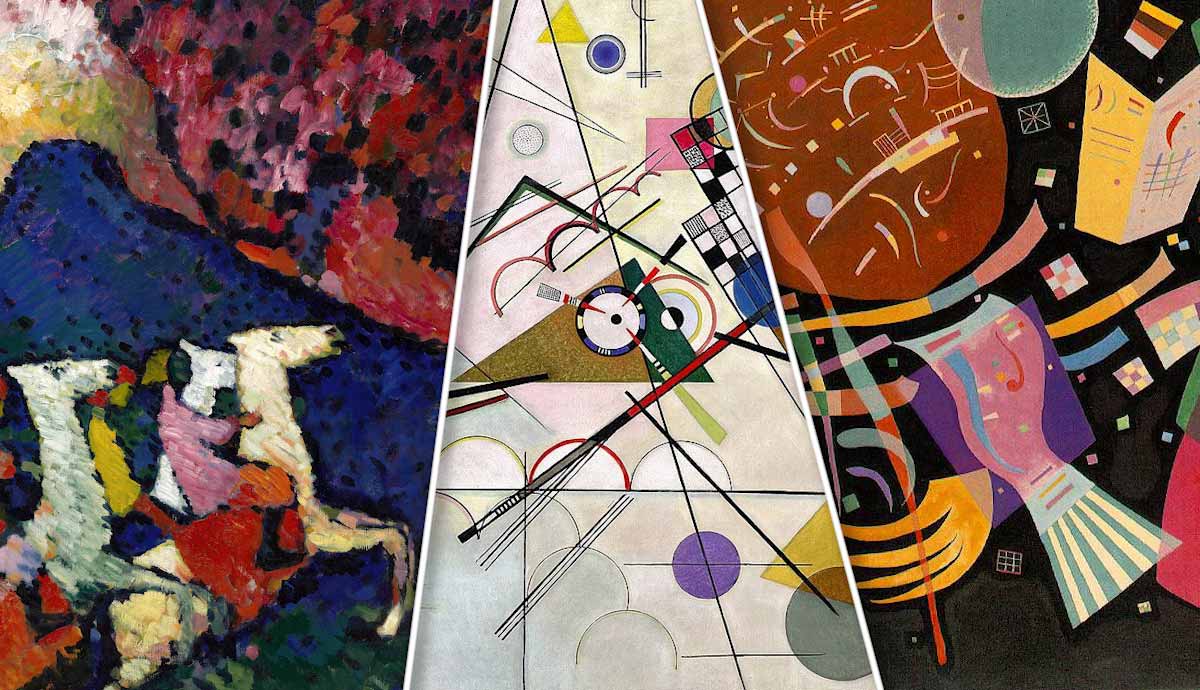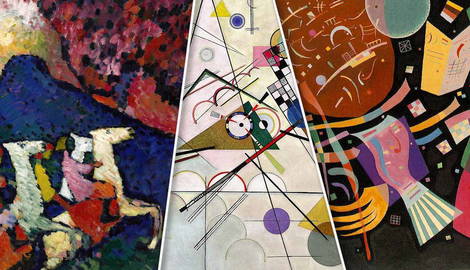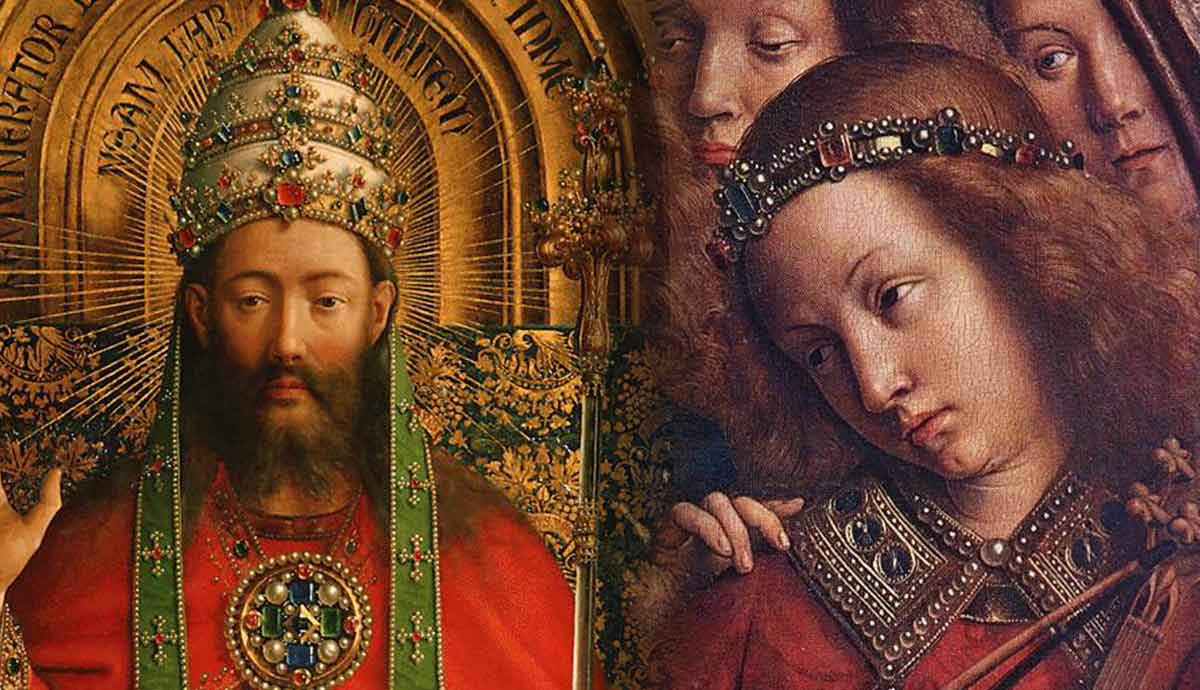
Before the 19th century, art was centered around naturalistic depictions designed to create a realistic window onto the world. Artists were inspired by history, mythology, and the Bible, with Michelangelo, Caravaggio, and Vermeer representing the pinnacle of artistic expression. It was only in the mid-1800s that less formal and more abstract forms of expression were embraced. Wassily Kandinsky was a key figure in the rise of non-objectivity in art. These are his six most significant artworks, which summarize Kandinsky’s career and the evolution of his art.
Who Was Wassily Kandinsky?

Wassily Wassilyevich Kandinsky (1866-1944), sometimes stylized as Vassily or Vasili, was born in Moscow, Russia, on December 16, 1866. Raised in Odesa in modern-day Ukraine, Kandinsky was the son of a tea merchant. Despite his later fame, he would not start painting until he was in his 30s. Still, he tailored an artistic lifestyle for himself, inspired by the music education he received as a child when he learned to play piano and cello. This experience would prove instrumental to his work.

After graduating from the University of Moscow at the age of 26 with degrees in law and economics, Kandinsky taught Roman Law at the University of Dorpat in Estonia. Despite his promising career in jurisprudence, Kandinsky quickly shifted towards the artistic world, highly inspired by experiences with music and color as a child. In 1897, he moved to Germany and studied under Anton Azbe, a Slovene realist painter. He was then taught by symbolist Franz von Stuck at the Kunstakademie in Munich. During this period, Kandinsky started showing immense promise in both his artistic and theoretical work.
1. Blue Mountain, 1908-09

Once Kandinsky finished his art education, he turned back to teaching in 1901. He first taught art as the director of the Phalanx School of Painting, an art group he created with three other artists. While this group was short-lived, it kick-started Kandinsky’s interest in teaching art. After traveling for a few years, he settled back down in Munich, where he then became president of the Munich New Artists’ Association. He soon became bored with the traditional aspect of the group, disagreeing with many of its members, and left his post in 1911. He shifted his focus to creating his own group, which exemplified his turn to abstraction.
Blue Mountain represents a turn away from linearity, marked by the visible brushstrokes, similar to Impressionist and Post-Impressionist artists like Monet or Van Gogh. Kandinsky called on an experience of seeing Monet’s Haystack series and being enraptured by his use of color and light. His early works are reflective of Impressionism, as many of them are still representational. Here, the viewer can see two horseback riders–a common theme in Kandinsky’s works. Primary colors are the focus of this piece, with the yellow and red trees framing the titular blue mountain. While this representation is far from realistic, it is also quite far from Kandinsky’s later abstractions.
2. The Blue Rider, 1903.

Der Blaue Reiter was a group created around 1912 for the publication of the group’s Almanac. Here, Kandinsky and fellow artist Franz Marc composed a collection of essays written by themselves, along with composers and critics. Most of the artworks featured in the Almanac represented this stark removal of European artistic conventions and instead drew inspiration from “primitive” art. The title of both the group and the Almanac, translated as The Blue Rider, was simply designated by Marc’s love of horses and Kandinsky’s fascination with the color blue. Some have argued that the name of the group came from this 1903 painting by Kandinsky.
In his The Blue Rider piece, there is an apparent move away from traditional representations in art. Like Blue Mountain, this work is still figurative, seen again by the horseback rider in the right half of the canvas, but it starts to lean into abstraction with its thick, broad brushstrokes. This stylistic form of line works well with the movement of the subject, with the “brushiness” representing the speed of the horse. Yet, the linework also lends to a little bit of confusion. The horse and trees are quite visible, but there are some white shapes on the left that are unclear. While this work is a little more naturalistic and less abstract than Blue Mountain, the influence of Impressionism is still evident.
3. Color Study: Squares with Concentric Circles, 1913.

At the beginning of World War I, Kandinsky moved back to Moscow, where he would continue his artistic career. Der Blaue Reiter was dissolved by this time, but he remained a driving force in the art world. His publishing of Concerning the Spiritual in Art in 1910 kick-started his dive into art theory, earning him world recognition.
As detailed in Concerning the Spiritual in Art, the most important aspect of painting to Kandinsky was the use of color. Within his theory, he cataloged shades of color and explained their “psychic” impression. In Squares with Concentric Circles, Kandinsky created a study with watercolor to observe how different colors played off each other. The complementary reds and blues are juxtaposed while cool greens and purples reflect off one another; all working to create a mixture of hues. Some of the warm colors jut out towards the viewer, whereas the cool tones recede into the canvas, forcing the audience to feel a sense of movement despite the stagnant shapes. Through his abstraction, Kandinsky was able to break down art to its absolute fundamentals, leaving infinite room for interpretation.
4. In Grey, 1919

While Kandinsky was in Russia, he was a proponent of advancing Russia’s art education, helping to establish both the Museum of the Culture of Painting and the Institute of Artistic Culture. During this period in Russia, Kandinsky honed his craft, turning further and further away from objectivity in every painting he created. He was largely inspired by the Russian avant-garde with suprematist artists like Malevich, Rodchenko, and Popova. Like great artists before him, Kandinsky was also inspired by Christian eschatology as a devout Orthodox Christian. He drew on biblical stories, including Noah’s Ark and the Four Horsemen of the Apocalypse, as well as Russian folktales and mythology. He never attempted to depict any of these stories as a narrative, but used their veiled imagery as symbols of the archetypes of death-rebirth and destruction-creation.
In Grey is one of the few carefully studied works of Kandinsky from his time in Russia. A large format work, it presents a dense complex of abstract forms in muted, cool shades of grey, brown, and blue. Surviving pencil sketches suggest that Kandinsky originally started with organic motifs, including a sun and a boat with oarsmen, but in the final painting, these are transformed into free constellations of color and form.
5. Composition VIII, 1923.

Kandinsky moved back to Munich after the war, where he began teaching at the Bauhaus art school in 1922. Some of his most famous pieces were created then, including his Composition series. The theme of the first seven of his Compositions was the apocalypse, composed in the years before World War I, which tied into his description as the “artist as prophet.” The title of Composition calls on another one of Kandinsky’s largest inspirations, music. Similar to his experience seeing a Monet exhibition, he was greatly transformed after witnessing a performance of Richard Wagner’s Lohengrin early in his life. Kandinsky is said to have experienced a neurological sensation called synesthesia, defined as the conflation of senses.
When he heard music, Kandinsky would see specific colors, and when he observed color, he would hear a specialized instrument. In Composition VIII, Kandinsky creates a cacophony of shapes, representing the turbulent postwar conditions of Europe, especially of the Weimar Republic. In trying to read this work like a piece of music, there is a symphony of dissonance splattered across the canvas. The looming glowing circle in the upper left corner is foreboding, while the chaos of the shapes below may remind one of a battlefield. Spheres bounce off lines, which slice through triangles, attacking squares. Yet, the calming white background may give the viewer a different impression of the scene.
6. Composition X, 1939.

Kandinsky had great success during the 1920s. Die Blaue Vier (The Blue Four) was founded by four Expressionists, including Kandinsky, Feininger, Klee, and Jawlensky. The goal of this group was to market all their artworks together to sell abroad in the United States. Kandinsky had his first solo American exhibition at the Société Anonyme in 1925. This group gave him even further international recognition. Yet, with World War II on the horizon, as well as age catching up to him, Kandinsky’s works slowed, but not before completing his most famous series.
One of his last paintings was Composition X, the final piece of his Composition series. Bringing the sequence to a head, this work lays on a background of stark black, relatively uncommon for his canon. According to the spiritual intonations of color from his theory, this black may represent closure. There is a jarring lack of outlines on these shapes, an unorthodox convention, even for Kandinsky. The colors are bright yet less saturated than his usual color palette. This work symbolizes the end of all things, as the shapes float around in an endless abyss.
The Last Days of Wassily Kandinsky

Kandinsky followed the Bauhaus to Dessau in 1925 and continued to teach there until it was closed down by the Nazis in 1933. A portion of his oeuvre was stolen and either destroyed or sold during Nazi seizures of art. Artists like Kandinsky were deemed degenerate due to their abstract style. This, unfortunately, leaves scholars in the dark for parts of Kandinsky’s life. His first three Compositions survive only in black-and-white photos. Kandinsky moved to Neuilly-sur-Seine, France, just before the outbreak of the war. Here, he would produce some of his final masterpieces. He died on December 13, 1944, just a few days before his 78th birthday. The first of his Compositions was destroyed by a British air raid in the city of Braunschweig in Lower Saxony on the night of 14 October 1944, just two months before Kandinsky’s death.
Kandinsky stated in Concerning the Spiritual in Art that an authentic artist created art from an internal necessity, and that the artist inhabits the tip of an upward-moving pyramid. This pyramid is progressing into the future, where what was off or inconceivable yesterday becomes commonplace and the avant-garde becomes accepted knowledge. The artist as prophet stands alone at the apex of the pyramid, making new discoveries and ushering in tomorrow’s reality.










